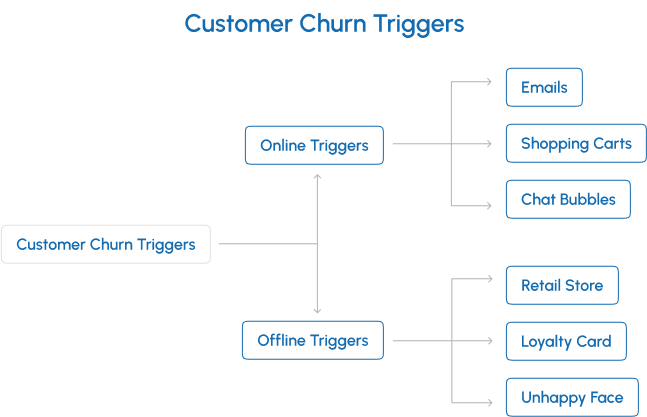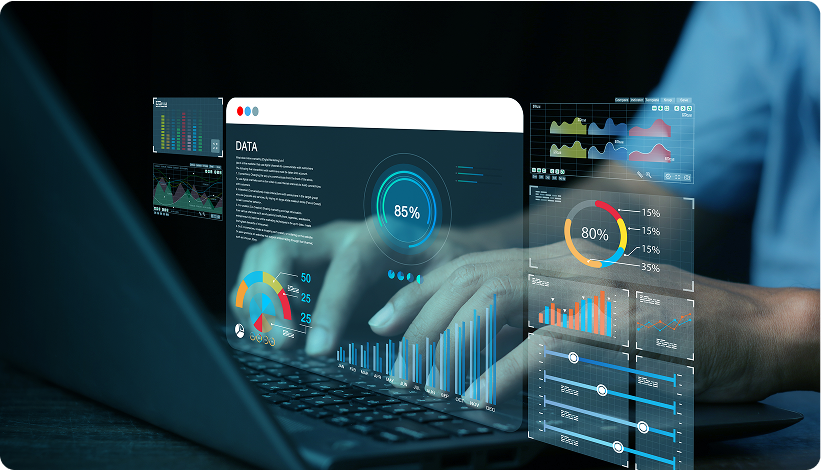
Introduction: The Cost of Lost Customers
We’ve all heard the old saying: “It costs five times more to acquire a new customer than to keep an existing one.” Yet, many businesses still pour huge budgets into new customer acquisition while neglecting the ones they already have.
In today’s hyper-competitive markets, customer loyalty can vanish in a single click or a missed connection. A single bad experience, a better deal elsewhere, or a moment of feeling unseen, that’s all it takes for a loyal customer to leave.
The problem? Many businesses realize a customer is gone only after the damage is done. By then, winning them back is much harder and costlier.
This is where Customer Churn Prediction powered by AI changes the game. Instead of reacting to churn when it’s too late, businesses can now predict when a customer is about to leave, and act early to change the outcome.
Why Customers Leave: Online vs. Offline Triggers
To stop churn, you first need to understand why customers leave. It’s rarely sudden, churn often creeps in through subtle signs.
Online churn triggers:
- Customers stop opening your emails.
- They abandon carts more often.
- They don’t respond to promotions like they used to.
- They reach out to support more frequently and not always happily.
Offline churn triggers:
- Fewer store visits over time.
- Lower participation in loyalty programs.
- Negative in-person experiences, like poor service or product issues.
Sadly, these signals slip through the cracks. Many businesses don’t piece them together until the customer is long gone.
Did you know that, according to studies, about 68% of customers leave because they feel a company doesn’t care about them? It’s rarely about price alone.
Customer churn can start from many small signals, both online and offline. Here’s a quick look at some common triggers to watch for

What Businesses Miss That Leads to Unnoticed Churn
So, why do these clear signals still go unnoticed?
One big reason: data silos.
Online data sits in one system, your website analytics, email tools, app data. Offline data, in-store visits, loyalty scans, purchase receipts, lives somewhere else. They don’t talk to each other.
Another issue is that many businesses still focus mainly on transactions. They track what was bought but overlook how the customer behaves before and after.
Subtle signs like fewer logins, longer gaps between purchases, or a sudden surge in support tickets, these passive signals often stay buried in the noise.
Finally, many companies simply don’t have an automated way to flag these signals in real time. By the time a human notices, it’s too late.
McKinsey found that companies that use customer behavioral insights outperform peers by 85% in sales growth. That’s the power of seeing what others miss.
How AI Predicts Customer Churn Before It Happens
Here’s where AI steps in as your early-warning system for churn. Let’s break down how it works.
Behavior Monitoring Across Channels
AI tracks every touchpoint like clicks on your website, email opens, mobile app usage, AND physical behaviors like store visits or loyalty card swipes. It creates a 360-degree view of each customer, combining digital and physical footprints.
So, if someone who used to visit your store every week hasn’t shown up in a month and hasn’t opened your last three emails, the system notices.
Pattern Recognition with Machine Learning
AI doesn’t just collect data, it learns from it. It compares each customer’s behavior with patterns of previous churners. For example, it might find that people who reduce their purchases by 30% over two months and contact support twice as often are 80% more likely to churn.
These hidden patterns are nearly impossible for humans to spot at scale. Machine learning models excel at catching them early.
Churn Scoring and Risk Classification
Finally, AI assigns each customer a churn probability score, how likely they are to leave soon.
You can then prioritize high-risk customers for retention actions like special offers, personal calls, or loyalty perks.

Data Sources That Power Churn Prediction
For Customer Churn Prediction to work well, you need good data. AI models thrive on rich, diverse information.
Here are the most common data sources businesses use:
- CRM: This is where you store customer details, who they are, what they bought, and when they last talked to you. If someone who used to buy every month hasn’t in a while, that’s a sign.
- Loyalty systems: If a customer usually earns and spends loyalty points but suddenly stops, they might be losing interest or shopping somewhere else.
- Transactions: What people buy, how often, and how much they spend tells you if something has changed. A drop in spending can mean they’re thinking of leaving.
- Helpdesk tickets: Complaints are important signals. If someone contacts support more than usual or keeps having problems, they might be unhappy and ready to leave.
- Web & app analytics: Did a customer stop logging in? Are they not browsing as much? Fewer visits and clicks mean they’re less interested.
- Email marketing tools: If loyal customers stop opening your emails or clicking your offers, it’s a clear sign their interest is dropping.
- POS systems: In physical stores, your POS system shows who’s buying, returning, or not visiting anymore.
When all this data comes together, you get a unified customer view, the secret ingredient for accurate churn prediction.
Many companies start by integrating just a few key data streams and expand over time. Even small steps can uncover surprising insights.
Business Benefits of AI-Based Churn Prediction
So, what’s in it for your business when you get Customer Churn Prediction right? In a word: loyalty — and loyalty means profit. Here’s how AI turns early warnings into real results:
Catch Problems Early — Keep More Customer
Instead of waiting until a customer disappears, you see the signs when they’re thinking about leaving. That gives you time to pick up the phone, send a caring check-in email, or surprise them with an offer that says, “Hey, we see you — and we care.”
Outreach That Actually Feels Personal
Nobody likes a generic “Hey valued customer” email. With AI, you don’t have to guess. You know who’s at risk and why, so you can send them exactly what they need to come back: a thank-you discount, a special perk, or just a human touch.
Spend Less, Win More
Blanket discounts for everyone? That’s old-school and expensive. With churn prediction, you can focus your budget and effort on the small group that really needs attention, so your marketing dollars work smarter, not harder.
Build Relationships That Last
When you show up for customers before they leave, you prove you value them, not just their money. Over time, this builds trust and loyalty that your competitors can’t easily steal. Loyal customers don’t just stick around, they bring friends.
Studies show that increasing customer retention by just 5% can boost profits by up to 95%. That’s the real power of keeping good customers happy.
Real-World Use Cases
Let’s make this real. Here’s how different industries use Customer Churn Prediction today.
- Retail: A large retailer uses AI to flag customers who haven’t visited stores in months but still browse online. They send them personalized “We Miss You” offers that pull them back in.
- Telecom: A telecom company notices when a customer’s data usage drops or they call support with unresolved issues. They proactively reach out with plan tweaks or perks to retain them.
- Banking: Banks track dormant accounts or reduced credit card spending. AI helps identify customers at risk of switching to competitors and nudges them with personalized offers.
- eCommerce: Online stores use AI to spot frequent cart abandoners or declining session frequency. They deploy timely reminders, discounts, or chat support to win them back.
Conclusion: Predict Churn Early, Win Loyalty Continuously
Customer churn is inevitable, but it doesn’t have to catch you by surprise. With AI-powered Customer Churn Prediction, businesses can turn churn management into a proactive strategy instead of a last-minute scramble.
The result? Happier customers who feel valued. More revenue from loyal relationships. And less wasted spend chasing new customers to replace the ones who quietly slipped away.
In a world where loyalty is earned one interaction at a time, predicting churn early isn’t just smart, it’s essential. Now is the time to invest in the data, tools, and models that help you hold on to your most valuable asset: your customers.
Don’t Lose Good Customers — Let’s Help You Keep Them
With AI-powered Customer Churn Prediction, you can spot who’s about to leave and win them back before it’s too late.
Want to get started?
Contact us today and see how we can help you keep more of your customers happy and loyal.






